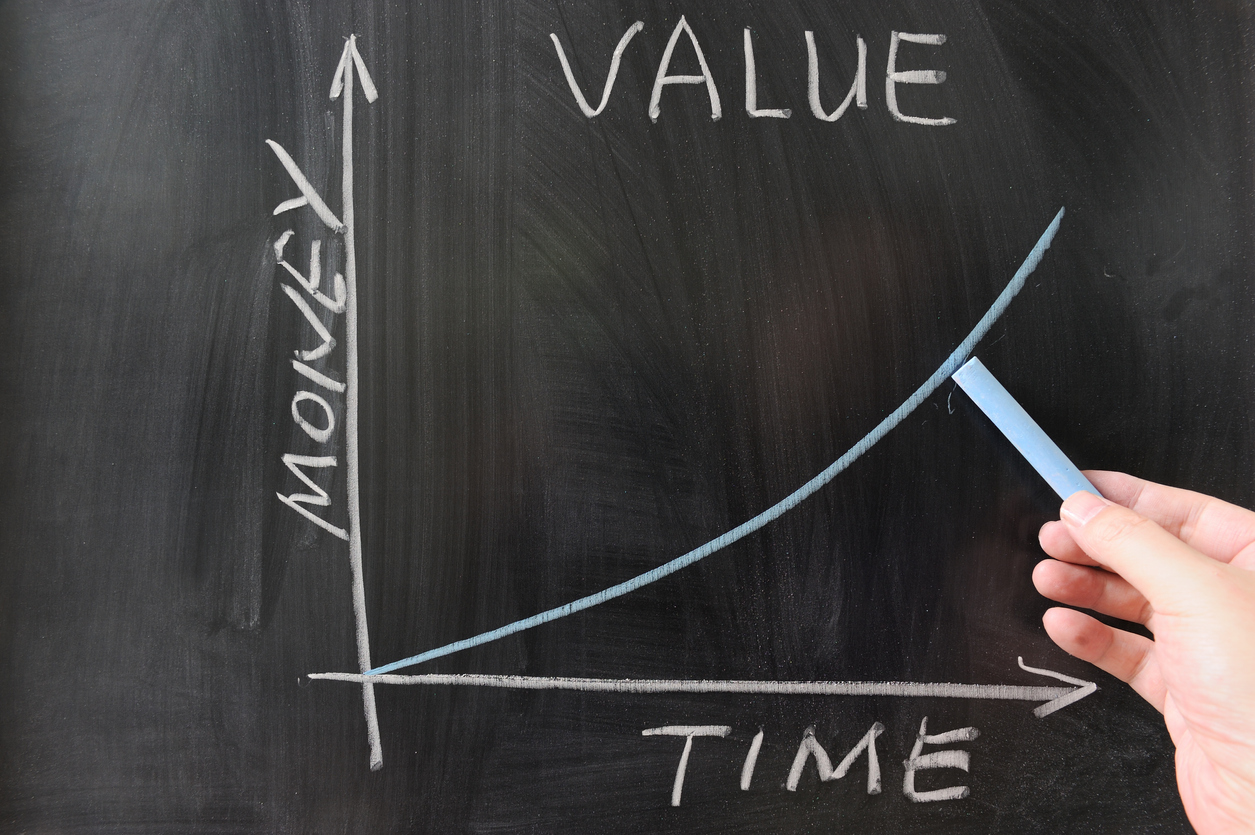Time Value of Money describes this phenomenon: Money will have less value in the future than it does in the present. This is not to be confused with inflation, where the value of a currency fluctuates because of market variables. Instead, it illustrates the importance of opportunity when investing in the stock market.
Let’s break down the definition of Time Value of Money (TVM), how it can be calculated, and why knowing your TVM can help you succeed in the United States stock market.
The Basics of Time Value of Money
The concept of Time Value of Money suggests the sum of money in your hand today has greater value than the same amount of money received in the future. This is because of the earning potential of your present money—you can turn that money into greater gains than if you let it sit in a banking account.
Let’s take a look at an example:
Investing $12,000 into the stock market may result in greater returns in five years. Meanwhile, leaving the same $12,000 in a bank account for five years will guarantee that money remains the same in value.
In short, the future value of your money will always be lower if you don’t invest because of the lost opportunity to grow your wealth.
How to Calculate The Time Value of Money
The formula for calculating the time value of money is as follows:
FV = PV x (1 + (I / N))^(N x T)
To know how to calculate Time Value of Money, there are five variables you need to be aware of. We’ll spell each of them out below:
1. Future Value of Money (FV)
The future value of money (FV) is the value of a certain sum of money at a future date.
FV is our result in this equation. Instead of waiting to see the resulting return, investors want to predict that future value to determine whether or not the investment is worth their time.
For the complexities of TVM, it’s worth going through the above equation to determine what the future value will be. However, there are other formulas you can use to get a rough estimate of what your investment can turn into.
Let’s walk through two of these formulas, which utilize compound and simple interest rates:
Simple Annual Interest
FV = Investment amount x (1 + (Interest rate * Number of years))
This formula works under the assumption of an unchanging, simple interest rate on a single investment, with the interest rate only applying to that initial investment. For example, let’s assume you invest $2,000 for 10 years with an interest rate of 10%:
$2,000 x (1 + (0.10 x 10)) = $4,000
Compound Annual Interest
FV = Investment amount x (1 + Interest rate)^Number of years
This formula also operates with an unchanging interest rate on a single investment, but the principal changes each year to include accrued interest. While they began with $2,000, their investment with a 10% yearly interest rate added $200. Thus, next year’s compounding interest rate would apply to the new total: $2,200.
To put that into perspective, let’s say you invest with compound interest for 10 years:
$2,000 x (1 + 0.10)^10 = $5,187.48
2. Present Value of Money (PV)
The present value of money is simply the current value of your initial investment.
This variable is the easiest to identify in this equation because any outside variables don’t control it. If you invest $20,000, then your present value of money is $20,000.
Your present value of money will increase with each additional deposit you make into your investment; this variable may be described as the total money you have invested.
3. Interest Rate (I)
The interest rate is the rate of growth you can expect with your investment within a given time period. For example, if you have an annual interest rate of 5%, your investment would grow 5% in a year.
Central banks and the Federal Reserve control interest rates. Your financial institution should clearly define the interest rate, so you shouldn’t have too much troubling finding it.
4. Number of Compounding Periods (N)
The number of compounding periods is the frequency of which your investment is compounded. If your interest compounds once a year, you have annual compound interest.
Here’s a simple chart that shows how many periods are in a year for each level of frequency.
| Compounding Period Frequency | Periods Per Year |
| Daily | 365 |
| Monthly | 12 |
| Quarterly | 4 |
| Semiannually | 2 |
| Annually | 1 |
5. Time (T)
Finally, the last variable you need to consider is the amount of time between investment and the future date. This will determine how long your money has time to grow and accumulate higher value.

Why You Should Understand the Time Value of Money
The Time Value of Money indicates how much you can get out of your money from an investment. Therefore, it is critical to understand TVM for every investment opportunity so you can properly calculate risk and choose your investments wisely.
We’d also stress the importance of Time Value of Money regarding future planning. If you know exactly how much money you will have in the future, you can better prepare for what’s to come. And while it’s impossible to predict the exact dollar amount, knowing your TVM can give you a good idea of the investment’s outcome.
Confidently Invest with Vested Finance
When you have a better idea of the reward behind your investment risk, you can invest with much greater certainty and confidence. The Time Value of Money is one of the factors you should use to reach that confidence level.
A great way to invest in the U.S. stock market from India is to partner with Vested Finance. We are trusted by many of the top Indian banks and brokerage firms to help our customers grow their wealth in the American economy.
Sign up today to make better investment decisions.









